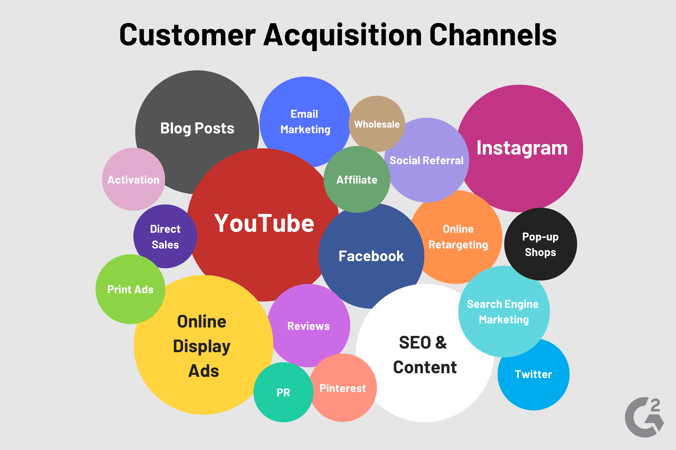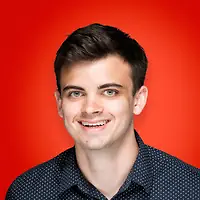
We can all agree on one thing: the marketing landscape is crowded.
In such a content-driven world, it’s become increasingly hard for a brand, product, or idea to stand out from the rest. Every day, we’re subjected to advertising from the moment we wake up until the second we lie down and close our eyes. Companies are trying to reach the widest audience possible in hopes of catching our attention and increasing their sales. This is the precise reason why having a strong marketing strategy is so important.
To capture the attention of the masses, designing and implementing a creative, interesting, and meaningful marketing strategy is a necessity. Your strategy impacts multiple stages of your customer’s experience with your brand and is the main factor that captures potential customers and leads them down the sales funnel.
How does growth marketing tie into your strategy? Well, it solely depends on it. First, let’s define what growth marketing really is.
Growth marketing is a marketing discipline that encompasses a handful of techniques and tactics that help businesses grow quickly and effectively. When implemented within a marketing strategy, it is the process of conducting experiments to assess areas that can be improved and optimized.
In this article, we’ll talk about how growth marketing works and how it differs from other forms of marketing. Let’s get started.
Feel free to jump ahead and read about any of the following topics:
How growth marketing works
The metrics to pay attention to
Growth marketing vs traditional marketing
How to implement growth marketing
Think of growth marketing as marketing 2.0. When a marketer uses growth marketing in their strategy, they’re taking the time to reassess content, optimize it, and make sure it’s still performing well. Some techniques marketers use can include A/B testing, SEO optimization, creative ad copy, data-driven email marketing campaigns, and value-add blog posts.
To fully understand growth marketing, let’s dive deeper.
Growth marketing has become more and more popular as companies push insane amounts of content out to their audience. Because the market is so crowded, it’s more important to make sure your content is accessible, relevant, and optimized for the now.
But how does a marketer do it?
Growth marketers are savvy by nature. Where a traditional marketer would buy a round of ads online, a growth marketer would focus on the ads they already have running and tweak them so that they’re refreshed, current, and optimized to target their audience once again.
Growth marketers are always tweaking ads, A/B testing which email campaign works better, and tinkering with landing pages. Their main goal is to increase their customer base as much as they are able.
There are a plethora of metrics that growth marketers pay attention to. Let’s go over a few:
Traffic is the growth marketer’s bread and butter. Driving more traffic to the company website or blog is a major goal of any strategy. There are several types of traffic growth marketers pay attention to:
Organic trafficWhen a website sees organic traffic, it means that someone out there searched for something using a search engine like Google or Yahoo and decided to click on your website. |
Paid trafficPaid traffic views come from visitors that land on your site because they clicked on your ad or call-to-action. |
Referral trafficThis traffic comes from every user that is directed to your site from social media or another website. |
Traffic of any kind is important because it lets Google know that people are visiting your site and that your content is important to others. In the long run, this will improve your site’s overall ranking and help you to reach more people.
|
TIP: Looking for another way to be found on Google, all while providing your customers with a platform to leave reviews and interact with one another? |
If people are finding your content and visiting your website, you’re doing something right. But what if they aren’t? Producing valuable content for your audience and making sure they’re finding it can be harder than it sounds.
Growth marketers always want to know what’s actually happening on their website. They’ll inquire about how many visitors are on the page, where they’re coming from, what content they’re clicking on, how long they’re on the page, and the actions they take while there.
Key areas that growth marketers should pay attention to should include increasing their conversion rate, seeing a spike in email subscribers, and leading a higher amount of customers down the funnel towards a purchase.
If you notice that certain pages on your site aren’t performing as well, tweaking your ad copy, images, or call-to-actions can make a difference. If you find that a certain phrase, image, or website design resonates well with customers and your conversions are going up, take note and implement it throughout your social platforms.
In short, the reason growth marketers are so data-driven is because they want to capitalize on the content they have already produced, the ads they’re already sent out, and the messaging they came up with weeks ago. Continually tweaking and tinkering with these things will help your company stay up to date, retain customers, establish brand awareness, and build a community.
Traditional marketing usually involves a marketing team brainstorming for content ideas, coming up with copy, creative ways to implement call-to-actions, designing graphics, budgeting for ad spend, etc. All of these things can be grouped together under the traditional marketing “set it and forget it” strategy.
Traditional marketers will carry out their marketing campaign, use their entire budget, and hope that something works. Doing this can help to build a company’s market presence, get customers intrigued, and get them to enter the top of the funnel. But that’s about it. There’s no use in marketing to an audience if your goal isn’t to lead them through the funnel with care.
This is where growth marketing shines.
When executed correctly, using growth marketing as an alternative to traditional marketing will attract customers, keep them interested, and turn them into brand evangelists.

Normally, companies put a lot of emphasis on the top of the funnel. After all, bringing customers in is one of the main goals of marketing in general. Techniques like content marketing can be utilized to bring them further down and closer to a purchase. Blog articles alone can attract customers to click on a conversion (like a call-to-action) where that user becomes a potential lead and is passed to the sales team.
Growth marketing doesn’t just focus on catching people’s eye, it’s main focus is to nurture an ongoing relationship with them and increase the number of times a single customer buys the offered product.
To achieve substantial growth, shift your focus to more than just getting a customer's attention. Now THAT’S growth marketing, baby!
At this point, you may be wondering how you can use growth marketing within your marketing efforts. In this section, we’ll talk about the steps you need to take to do so.
Companies all around the world share their content across a variety of channels. Every company will find success differently and have certain acquisition channels that do well, while others just… don’t.
Whether you acquire your customers on social platforms such as Twitter or YouTube or capture them with direct sales and online display ads, you’ll need to know which ones are worth focusing on to find even more leads.

To make any worthwhile changes, you first need to identify the areas that need tweaking.
It might be surprising to some, but the very top of your funnel is extremely prone to losing potential leads. Because it is the first time people see your brand, there is less of a commitment to stay. You should expect that at first, a good portion of your audience won’t be interested.

When leads reach the middle of the funnel, they’re going to start thinking about if your product or service is the right one for them. A lot of times, marketers won’t know how to keep the relationship with these leads fresh and moving along. Connecting them with a salesperson is the best possible option at this point. Failure to do so will result in a loss of lead and ultimately, a potential sale.
Ah, the bottom of the funnel. Here the lead takes the final step and converts to a customer. Although it may seem like you have the lead in the bag at this point, the bottom of the funnel is one of the most common places to see a loss of leads. If you’re not staying in contact with your leads, you’ll have more difficulty getting them to take that plunge and purchase.
Now that you’ve identified your weaknesses, it’s time for a brainstorm.
The most effective way to assess the cracks in your marketing campaign is to sit your team down and look at each problem separately. Each problem can be turned into an opportunity so don’t pass one by just because it seems like it’s working.
At this stage, don’t focus on setting plans in place, they’ll come. Pay attention to the weaknesses and brainstorm how you can better strategize to strengthen them going forward. Write everything down in a spreadsheet for future use and make sure to get a wide range of opinions and ideas. The more the merrier.
A number of factors will impact what problems you can solve. How easy is the problem to fix? Is there a cost involved? Will it hinder other processes? How can we measure it once it’s fixed? Who is going to be in charge of each problem?
Plan out a timeline with your team and start attacking your weaknesses. Problems that often come up when looking for vulnerabilities can include low conversion rate, low CTA clicks, potential customers backing out once inside the funnel. Once you start to address the issues, you’ll see what works and what doesn’t and hopefully, the customer/business relationship grows stronger.
The easiest way to decide which problems you should tackle can be determined by the size of your company. Smaller businesses often address problems that will have the most impact on their sales with the least amount of effort from the team. Larger businesses should prioritize issues that will yield the best gain in the least amount of time.
One of the more accurate ways to see if your new efforts are working is to check your analytics. Keep track of them for a couple of weeks and report back with your team to address if there needs to be any further action taken.
Understanding your analytics can be confusing. Find the best social media analytics software for your business a dive into your insights today.
The thing about growth marketing is that it can be time-consuming and a lot of marketers like to focus on top of the funnel content. But the secret is….focusing on the customer’s entire journey will pay off in the long run.
The first step to becoming a growth marketer is to have the drive. Being data-driven, dedicated, and willing to continually tweak your campaigns is what makes a good growth marketer. The sooner you identify the areas that can be improved within your marketing strategy, the sooner you’ll be able to keep your content relevant and keep people coming back for more.
Want to know how you can keep things fresh? Read up about evergreen content.
Alexa is a former content associate at G2. Born and raised in Chicago, she went to Columbia College Chicago and entered the world of all things event marketing and social media. In her free time, she likes being outside with her dog, creating playlists, and dabbling in Illustrator. (she/her/hers)
The pressure of sending an email to thousands of subscribers can be a lot to worry about when...
 by Rob Browne
by Rob Browne
When was the last time you asked for someone’s opinion before buying a product?
 by Alexa Drake
by Alexa Drake
The buyer's journey consists of awareness, consideration, and decision. That final conversion...
 by Daniella Alscher
by Daniella Alscher
The pressure of sending an email to thousands of subscribers can be a lot to worry about when...
 by Rob Browne
by Rob Browne
When was the last time you asked for someone’s opinion before buying a product?
 by Alexa Drake
by Alexa Drake

